
It’s been a while since the last composition post, so let’s waste no further time and get into planning. Wait, somehow that doesn’t seem quite right…
No matter what the preferred style, sooner or later every photographer gets into planning a shot; envisioning exactly how they want it to appear, and then endeavoring to actually bring this out in the image. Some styles of photography largely demand this as a matter of routine (like studio portraiture and commercial model shoots,) while others rarely delve into the practice at all (nature photography, candids, etc.) It can be very nice to simply snap off the image that you wanted without planning or imagining it, but very often, the shot that is planned, at least to some extent, comes out better overall.
The image at top seems like a simple time exposure, taken from an overpass at night, but there was a lot that could make this weaker, or outright detract from the image. Headlight glare can be pretty intense, so a position offset from the oncoming cars was chosen. Too many cars will overlap and muddy the frame, but empty lanes can make the road seem unbalanced. This was taken right where an on-ramp merged in, so getting a single car in each of the eight lanes available, for the eight seconds of exposure time, would be pretty tricky. As it was, only two cars came through on the oncoming side, both sharing the same lane, and even one of the lanes beneath the camera was empty, yet the remaining vehicles helped balance out the composition – the one at far right was a truck with extra running lights, so it produced a nice collection of streaks without overlapping as multiple sets of taillights might’ve. Timing the exposure to start just as the close vehicles emerged from under the bridge maximized their time in the frame, and wonder of wonders, one driver was even captured using their turn signal properly. Must not have been a local…
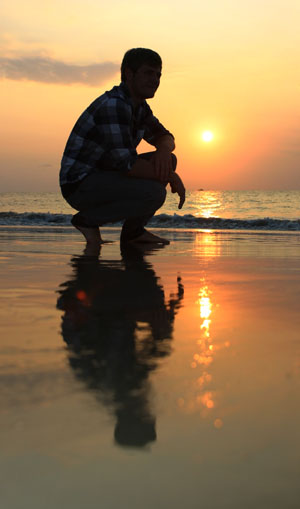 From a nature photography standpoint, as well as portraiture, one of the better bits of planning is using the best natural light. Sunrise and sunset, often referred to as the ‘golden hours,’ offer softer, low-contrast lighting that has a pleasant warm hue, not to mention often producing nice displays in the sky, so being in position when this occurs can be very useful. If you don’t have a developed sense of where the sun will be, a compass and any online guide or app can tell you exactly where it will contact the horizon, allowing you to use this tiny window to frame the sun (or moon, as it may be) against some foreground interest. The colors change rapidly at these times, and the best displays may last only a minute or so.
From a nature photography standpoint, as well as portraiture, one of the better bits of planning is using the best natural light. Sunrise and sunset, often referred to as the ‘golden hours,’ offer softer, low-contrast lighting that has a pleasant warm hue, not to mention often producing nice displays in the sky, so being in position when this occurs can be very useful. If you don’t have a developed sense of where the sun will be, a compass and any online guide or app can tell you exactly where it will contact the horizon, allowing you to use this tiny window to frame the sun (or moon, as it may be) against some foreground interest. The colors change rapidly at these times, and the best displays may last only a minute or so.
Shooting into the bright sky like this is certainly going to affect exposure, often producing a silhouette. While it was not a technique used in this particular case (you may notice that I don’t show recognizable people without express permission,) having a flash unit handy to throw some fill light into the scene can produce a better portrait – but it also has to be the right level of light. A manually adjustable flash unit, or a variety of diffusing materials to soften the output, can allow you to throw just enough light to see detail without looking like the subject is unnaturally lit, so you’d best have these materials on hand. A reflector can also work, but usually needs another person to wield it with accuracy.

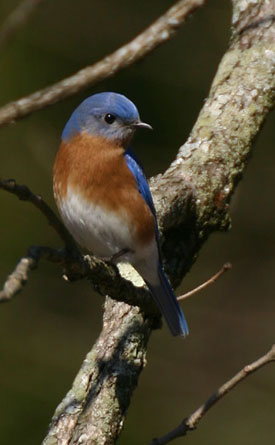 Anticipating the action is also an important facet. This might mean setting up a complete rig to be able to capture birds feeding their young without being close enough to spook them, with light levels adjusted ahead of time so everything’s ready when the action starts. Or it might simply be knowing what pose or position is going to work best, and being able to trip the shutter exactly when it occurs, no matter how fleetingly. Most animals look better with a bright point reflection in their eyes, called a ‘catchlight,’ but don’t often pose where this can occur because it also means that light is making it hard for them to see; thus it might happen for a second or less. Yes, this takes practice and fast reflexes – you’re seeing the successes here, but I have enough misses as well. A little forethought made me position myself so that the bluebird’s head fell in the gap between the background branches, rather than intersecting them in a distracting way, and then it was simply a matter of waiting until the bird turned to look in exactly the right direction.
Anticipating the action is also an important facet. This might mean setting up a complete rig to be able to capture birds feeding their young without being close enough to spook them, with light levels adjusted ahead of time so everything’s ready when the action starts. Or it might simply be knowing what pose or position is going to work best, and being able to trip the shutter exactly when it occurs, no matter how fleetingly. Most animals look better with a bright point reflection in their eyes, called a ‘catchlight,’ but don’t often pose where this can occur because it also means that light is making it hard for them to see; thus it might happen for a second or less. Yes, this takes practice and fast reflexes – you’re seeing the successes here, but I have enough misses as well. A little forethought made me position myself so that the bluebird’s head fell in the gap between the background branches, rather than intersecting them in a distracting way, and then it was simply a matter of waiting until the bird turned to look in exactly the right direction.
The more involved aspect of planning is, naturally, the studio shoot, whether this be a full modeling session or a small natural-looking setting for arthropods, or anything in between. It’s easy to imagine that taking an illustrative photo of an inanimate object for advertising purposes is easy – until you try it, and discover the issues with deep shadows, and reflections from shiny surfaces, and that there’s one angle that shows off the object with the necessary details, and so on. The same can easily be said for people, where different bodies or facial structures require different approaches to lighting, and the background has to complement the clothing, and let’s not even talk about trying to get the right expression from the model. But what all of these point to is having a lot of flexibility in equipment and approach, and this often means being able to cobble together something that works for the immediate needs. It can help to have a variety of lighting options, but it isn’t always necessary – a lot of effects can be achieved with homemade apparatus like reflectors, LED lamps, and tissue paper for diffusing overly bright or direct lights. However, you will almost always need something extra to make a studio session come out well, and it can take a lot of time and experiments to pin down what works best.
[A quick note: not long back, one of the primary tools of the studio photographer was a Polaroid back, an interchangeable film cassette for the medium or large-format cameras which permitted an immediate view of how the photo would look with certain lighting or sets. This was often necessary because the strobes used were not ‘constant’ lighting but fired only momentarily, and judging their exact effect couldn’t be done without capturing the instant of triggering. With digital, many studio photographers now have their cameras hooked into a large monitor for previewing in the same manner, because the dinky and poorly-corrected LCDs on the backs of the cameras just aren’t sufficient for critical evaluation.]

Above, a fairy shrimp (Anostraca) photographed within a custom-made macro aquarium that greatly limited its ability to move out of focus range, using a dark-field technique that brightly illuminated the body details against a black background. While not too elaborate to set up, it was a much easier way of illustrating a subject that measured only 8mm without a lot of aggravation trying to nail focus in an open aquarium, as well as not firing the flash directly into the camera lens.
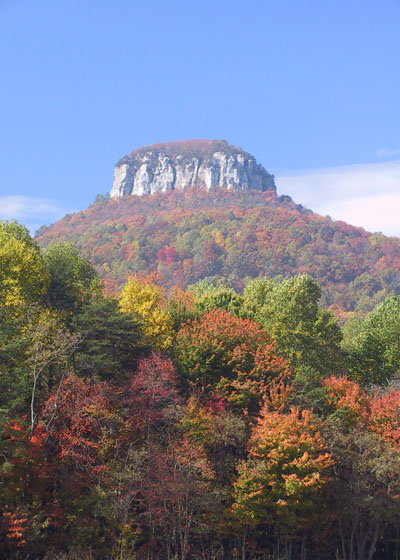




















































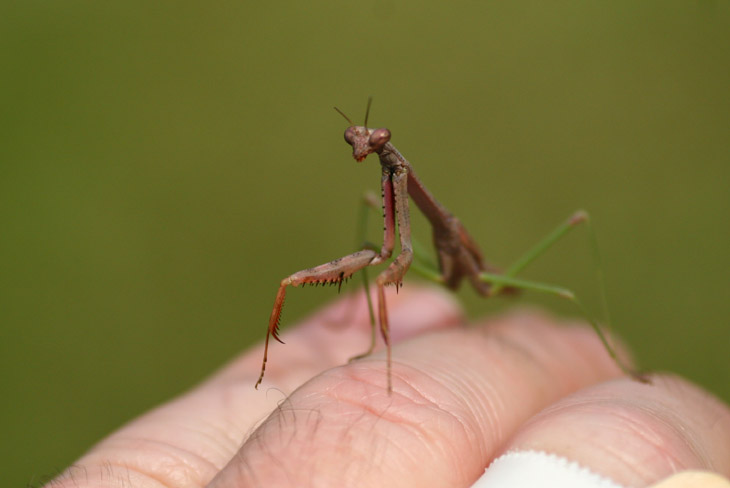
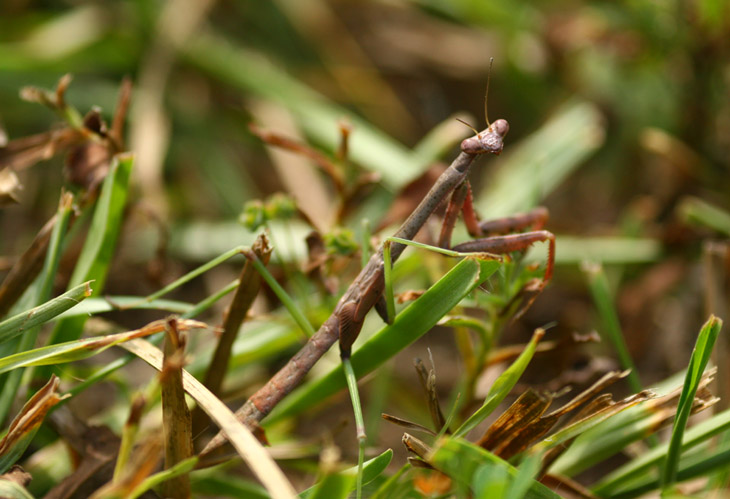
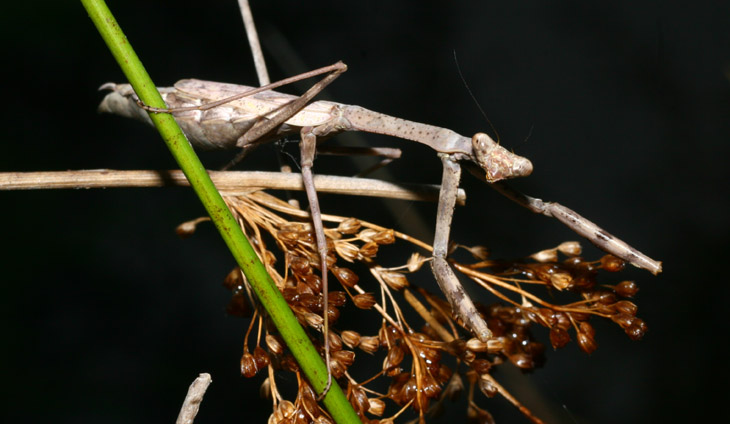
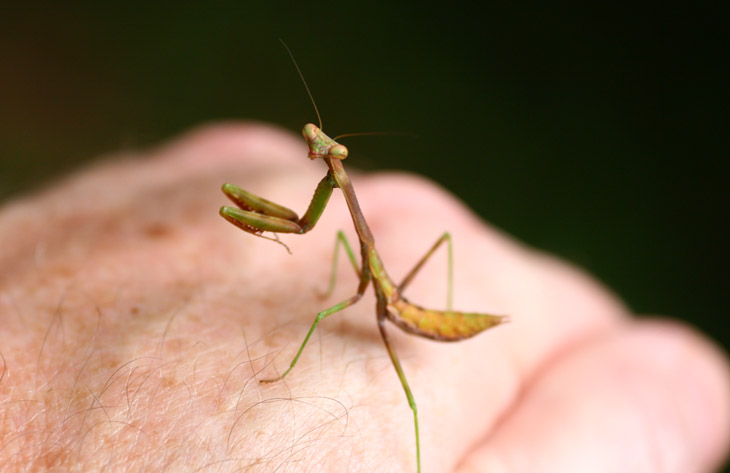
 [That’s two of my knuckles flanking the head, with my thumb peeking in at right.] This time, however, I knew exactly how it had gotten there, since I had just brushed past a low-hanging branch with that shoulder, so after the scale image, I returned it to its perch.
[That’s two of my knuckles flanking the head, with my thumb peeking in at right.] This time, however, I knew exactly how it had gotten there, since I had just brushed past a low-hanging branch with that shoulder, so after the scale image, I returned it to its perch.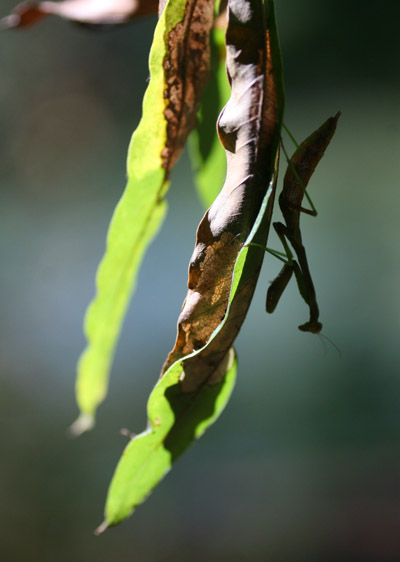 This one’s from yesterday, and as you can see, that abdomen is still pretty impressive. I can’t offer a decent explanation as yet – the tree is hardly one to attract a lot of potential mantis-meals. I am not discounting the possibility that, had I not acted sooner on that first encounter, the mantis may have been fatter still, feeding from those like me who frequently walk around the pond. But the path I took is one seldom used, because the spiders tend to throw their webs across between the trees and, for some reason, most people don’t like walking face-first through a large orb web – I’ve pointed it out many times before on this blog, but people are weird. However, this might help explain the girth anyway. The orb-weaver spiders don’t often encounter mantids because of their own protective habits, sitting in the middle of the web where mantids cannot reach, but they do at least have to begin the web, which requires stringing the support strands, and the outlying branch that the mantis owns is potentially a good anchor for such. So maybe the mantis had been fortunate enough to stumble upon a self-stocking smorgasbord, as it were.
This one’s from yesterday, and as you can see, that abdomen is still pretty impressive. I can’t offer a decent explanation as yet – the tree is hardly one to attract a lot of potential mantis-meals. I am not discounting the possibility that, had I not acted sooner on that first encounter, the mantis may have been fatter still, feeding from those like me who frequently walk around the pond. But the path I took is one seldom used, because the spiders tend to throw their webs across between the trees and, for some reason, most people don’t like walking face-first through a large orb web – I’ve pointed it out many times before on this blog, but people are weird. However, this might help explain the girth anyway. The orb-weaver spiders don’t often encounter mantids because of their own protective habits, sitting in the middle of the web where mantids cannot reach, but they do at least have to begin the web, which requires stringing the support strands, and the outlying branch that the mantis owns is potentially a good anchor for such. So maybe the mantis had been fortunate enough to stumble upon a self-stocking smorgasbord, as it were.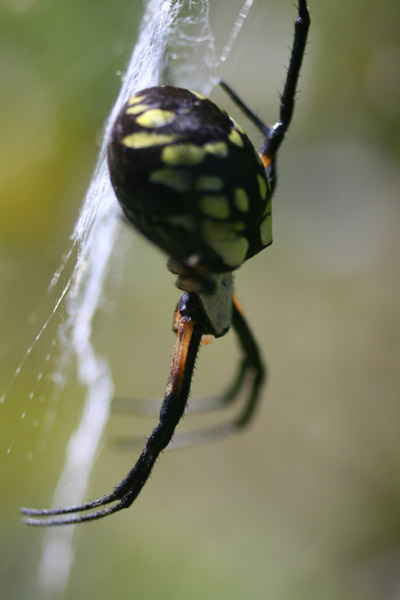 While I was faintly chagrined at having missed the hatching, I wasn’t absolutely sure a hatching had occurred. The egg sac might have been found and raided by a predator, a hypothesis buttressed by the fact that there was no evidence of a large number of web strands left behind by dozens of departing spiderlings. Not far away, though, another argiope was perched, and her girth was also evidence of an impending sac – this was taken four days ago. The thorn bushes she had selected as her web anchors prevented me from getting a better viewing angle, but as you can see, her belly’s to the sun anyway.
While I was faintly chagrined at having missed the hatching, I wasn’t absolutely sure a hatching had occurred. The egg sac might have been found and raided by a predator, a hypothesis buttressed by the fact that there was no evidence of a large number of web strands left behind by dozens of departing spiderlings. Not far away, though, another argiope was perched, and her girth was also evidence of an impending sac – this was taken four days ago. The thorn bushes she had selected as her web anchors prevented me from getting a better viewing angle, but as you can see, her belly’s to the sun anyway.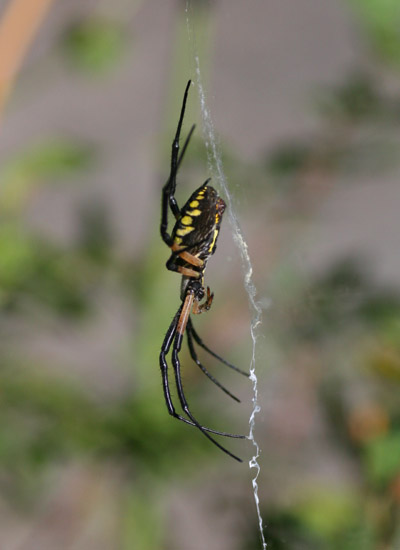 Yesterday, the same spider as above was noticeably deflated, as predicted, but I was unable to locate the egg sac. The foliage nearby was dense, and argiopes don’t put their eggs in the immediate vicinity of their webs, opting to go outside of the orb’s range a short ways (usually less than a meter) to place the sac. It was almost certainly there, but ten minutes of searching didn’t reveal it to me. I’m going to keep checking, because I really want photos of newborns, and if I capture them in the process of emerging, all the better. It will also be interesting to see if, now that the eggs are laid, this one disappears soon as well. Check back – if I’m successful, you know they’re going to appear here.
Yesterday, the same spider as above was noticeably deflated, as predicted, but I was unable to locate the egg sac. The foliage nearby was dense, and argiopes don’t put their eggs in the immediate vicinity of their webs, opting to go outside of the orb’s range a short ways (usually less than a meter) to place the sac. It was almost certainly there, but ten minutes of searching didn’t reveal it to me. I’m going to keep checking, because I really want photos of newborns, and if I capture them in the process of emerging, all the better. It will also be interesting to see if, now that the eggs are laid, this one disappears soon as well. Check back – if I’m successful, you know they’re going to appear here.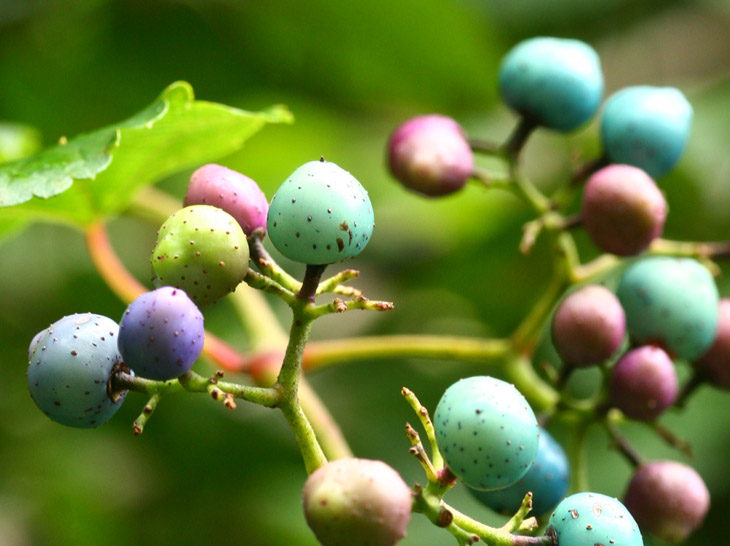

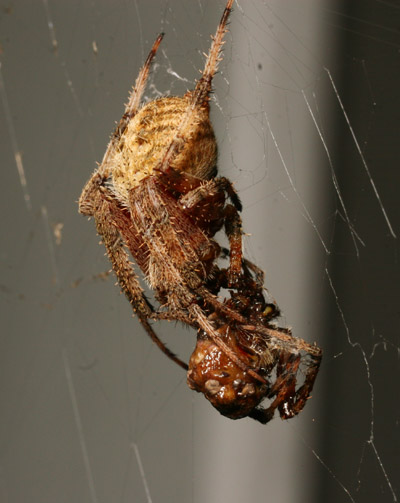 So, right outside the same porch mentioned in the previous post has been a pair of large orb webs occupied by
So, right outside the same porch mentioned in the previous post has been a pair of large orb webs occupied by  What I found was a vintage barn or railroad lantern, and it arrived in “as found” condition, complete with old spider egg sacs (barely visible to the lower right of the chimney.) It took a while to clean up, and the kerosene had stained the enamel around the base, but I figured that just added to the rustic charm. Despite the grime, it was in good enough condition that I could have filled it and lighted it immediately, and I debated about cleaning it up and reselling it, but I liked the look of it too much. Once cleaned, I removed the wick assembly and drilled a large hole in the bottom of the kerosene tank, then fed the lights up through the bottom and clustered them within the glass chimney. From discussion to result was less than two weeks, and from arrival to display less than two hours.
What I found was a vintage barn or railroad lantern, and it arrived in “as found” condition, complete with old spider egg sacs (barely visible to the lower right of the chimney.) It took a while to clean up, and the kerosene had stained the enamel around the base, but I figured that just added to the rustic charm. Despite the grime, it was in good enough condition that I could have filled it and lighted it immediately, and I debated about cleaning it up and reselling it, but I liked the look of it too much. Once cleaned, I removed the wick assembly and drilled a large hole in the bottom of the kerosene tank, then fed the lights up through the bottom and clustered them within the glass chimney. From discussion to result was less than two weeks, and from arrival to display less than two hours.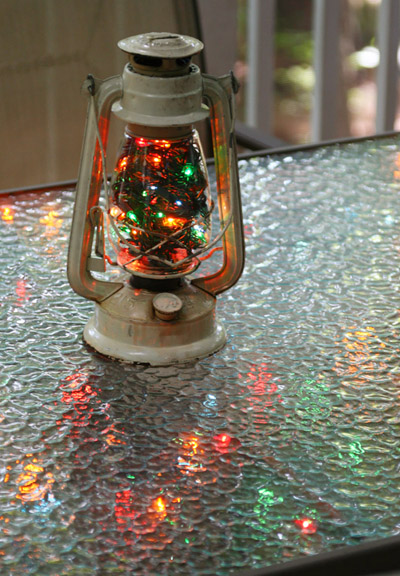 It looks quite nice in place, and my only regret is that it is not self-contained and running from batteries, with that fill-spout serving as the power switch. Even during the day, it produces a nice effect, but at night it really comes into its own. I know there are some people that think multi-colored lights are garish or old-fashioned; good for them. We’re pleased with the ensemble, and that’s the only criteria we need.
It looks quite nice in place, and my only regret is that it is not self-contained and running from batteries, with that fill-spout serving as the power switch. Even during the day, it produces a nice effect, but at night it really comes into its own. I know there are some people that think multi-colored lights are garish or old-fashioned; good for them. We’re pleased with the ensemble, and that’s the only criteria we need.
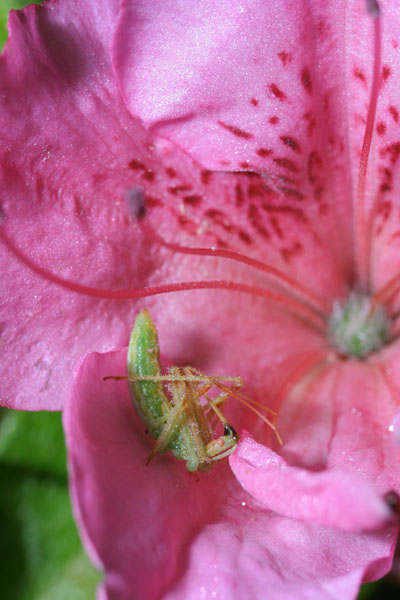 Looking at how the day is shaping up out there, it seems like this is a pink kind of day, so this image has been specially chosen to fit in with the conditions.
Looking at how the day is shaping up out there, it seems like this is a pink kind of day, so this image has been specially chosen to fit in with the conditions.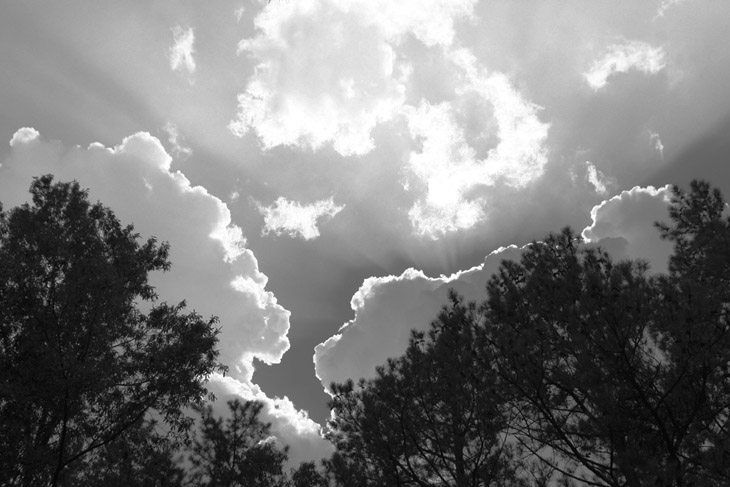
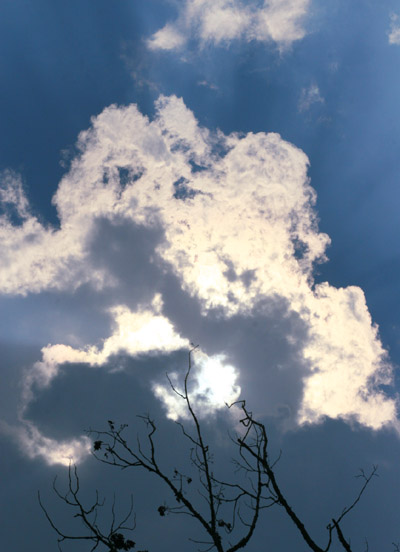 Yes, it’s still been a slow couple of weeks, and I’ve been working on some other projects, so the photography is leaner. Hopefully this is not yet the start of the downward trend that autumn brings.
Yes, it’s still been a slow couple of weeks, and I’ve been working on some other projects, so the photography is leaner. Hopefully this is not yet the start of the downward trend that autumn brings.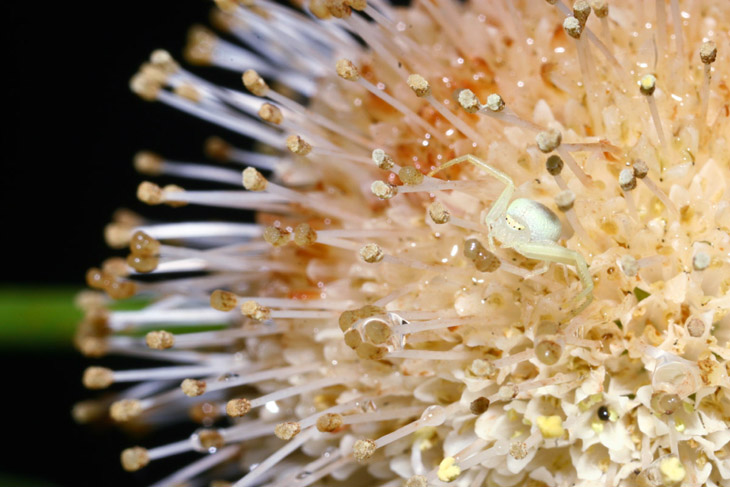
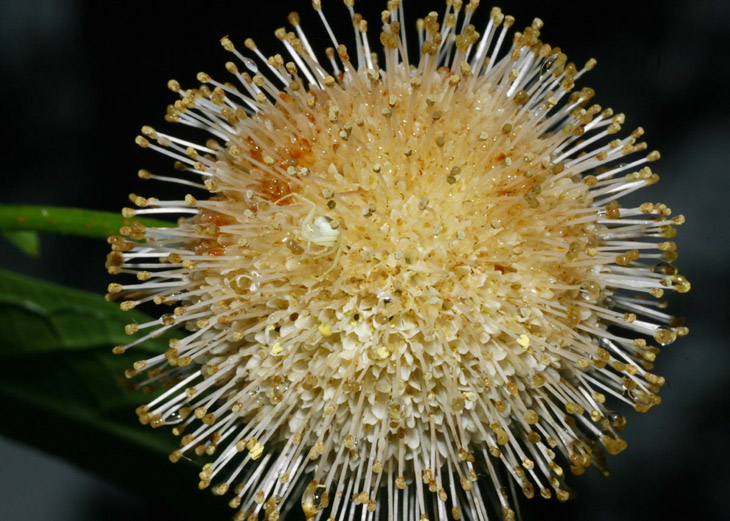
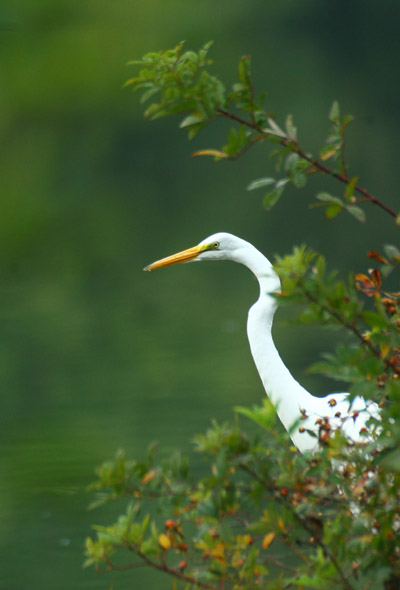 The storm may also have been responsible for the presence of a great egret (Ardea alba) at the pond these past few days, having been driven out of its normal range by the winds. I was used to seeing them in Florida all over, and along the NC coast, but haven’t seen one in this area in a long time. I’m not sure what the resident great blue heron thinks about this newcomer – it’s been the sole big wader for the entire pond, though I have spotted smaller ones for only a day or so – but the pond is big enough to support them both, and the green herons and others. We’ll just have to see if this one decides to stick around. It seems less wary than the great blue – this image was acquired with some very basic stalking – so if it remains for a bit, I might be able to do a more rounded gallery of images.
The storm may also have been responsible for the presence of a great egret (Ardea alba) at the pond these past few days, having been driven out of its normal range by the winds. I was used to seeing them in Florida all over, and along the NC coast, but haven’t seen one in this area in a long time. I’m not sure what the resident great blue heron thinks about this newcomer – it’s been the sole big wader for the entire pond, though I have spotted smaller ones for only a day or so – but the pond is big enough to support them both, and the green herons and others. We’ll just have to see if this one decides to stick around. It seems less wary than the great blue – this image was acquired with some very basic stalking – so if it remains for a bit, I might be able to do a more rounded gallery of images.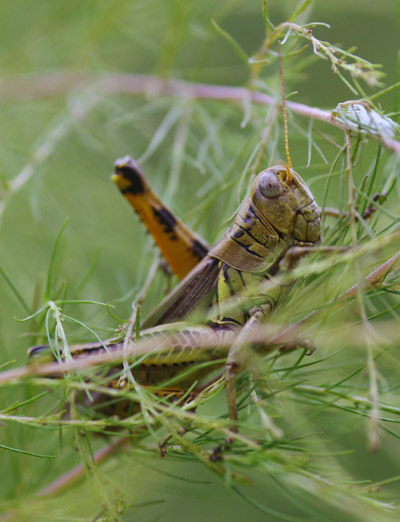 I can’t say if the storms had the slightest to do with these, all I can say is that abruptly, several individuals of this unidentified grasshopper could be found with little effort, when I have been seeing virtually nothing of the sort in the area before. These are big enough to be called ‘locusts,’ better than 5cm in overall body length, and while capable of doing a lot of plant damage, I suspect they won’t last long against the large number of birds and the nearby black-and-yellow argiopes (which have been chowing down on dragonflies and cicadas, and would probably relish the change of diet.)
I can’t say if the storms had the slightest to do with these, all I can say is that abruptly, several individuals of this unidentified grasshopper could be found with little effort, when I have been seeing virtually nothing of the sort in the area before. These are big enough to be called ‘locusts,’ better than 5cm in overall body length, and while capable of doing a lot of plant damage, I suspect they won’t last long against the large number of birds and the nearby black-and-yellow argiopes (which have been chowing down on dragonflies and cicadas, and would probably relish the change of diet.) I close with another crab spider, even smaller than the previous, remaining inconspicuous on the underside of a delicate white flower – I haven’t pinned this down for sure, but the flowering vine might be virgin’s bower (Clematis virginiana.) I’m going to have to confirm this because it produces a lot of flowers that we could use around the yard, and thus attract more insects and perhaps hummingbirds. Granted, bigger flowers are more likely to attract the
I close with another crab spider, even smaller than the previous, remaining inconspicuous on the underside of a delicate white flower – I haven’t pinned this down for sure, but the flowering vine might be virgin’s bower (Clematis virginiana.) I’m going to have to confirm this because it produces a lot of flowers that we could use around the yard, and thus attract more insects and perhaps hummingbirds. Granted, bigger flowers are more likely to attract the